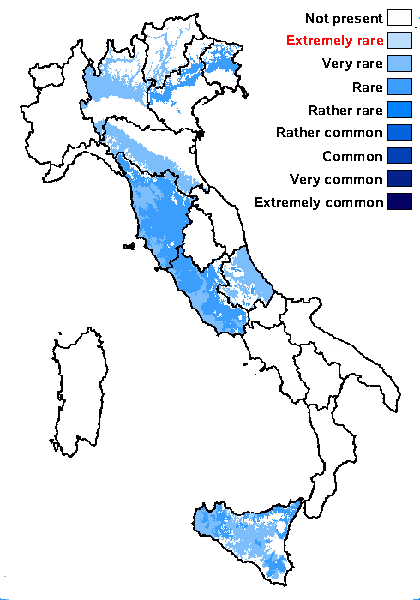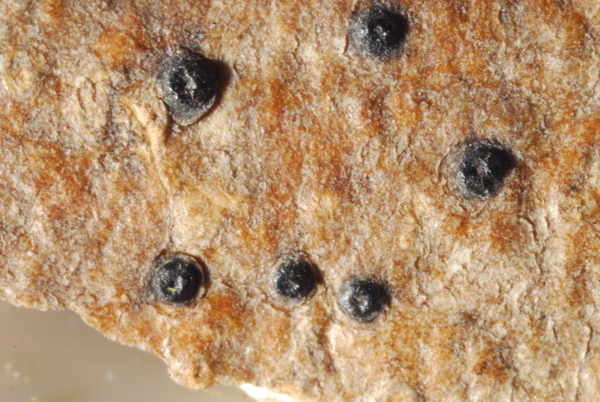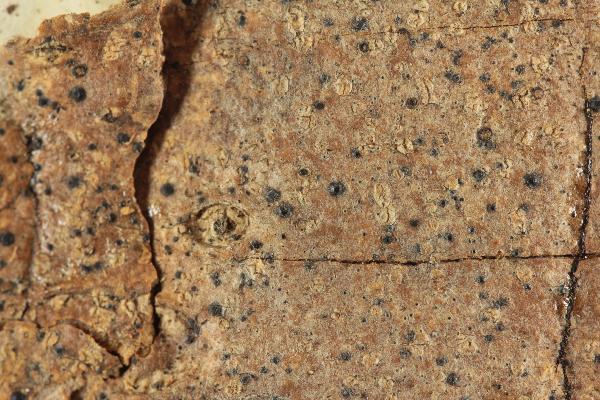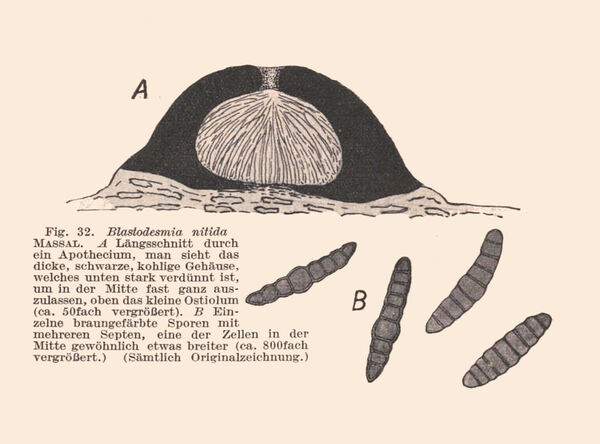Blastodesmia nitida A. Massal.
Ric. Auton. Lich. Crost.: 180, 1852.
Synonyms: Arthopyrenia pluriseptata (Nyl.) Arnold non auct.; Polyblastia nitida (A. Massal.) Trevis.; Pyrenula circumfusa (Nyl.) Trevis.; Verrucaria circumfusa Nyl.; Verrucaria massalongii Garov.
Distribution: N - VG, Frl, Ven (Lazzarin 2000b), TAA (Nascimbene & al. 2007b), Lomb, Emil (Fariselli & al. 2020). C - Tosc, Laz, Abr (Nimis & Tretiach 1999, Caporale & al. 2016). S - Si.
Description: Thallus crustose, endosubstratic, not lichenized, forming 1-2 cm wide, pale patches on the bark. Perithecia black, 0.4-0.6 mm across, half-immersed, the visible part projecting, hemispherical, shiny black, sometimes depressed near the ostiole. Exciple black and carbonized throughout; paraphyses filiform, euseptate, simple, free, disappearing early. Asci narrowly cylindrical, long-stalked, multilayered, the apex with an internal apical beak and a refractive subapical cap, I-, K/I-. Ascospores 5-9-septate, constricted at septa, grey to brown, rounded at apices, with rectangular cells, the central cell larger, (24-)28-37(-47) x 6-10(-12) µm. Pycnidia black, immersed. Conidia colourless, straight, 3-5 x 0.5 µm. Spot tests: thallus K-, C-, KC-, P-, UV-. Chemistry: without lichen substances. Note: a typically submediterranean, probably not lichenized early coloniser of smooth bark, especially of Fraxinus ornus.
Growth form: Fungus
Substrata: bark
Reproductive strategy: mainly sexual
Most common in areas with a humid-warm climate (e.g. most of Tyrrenian Italy)
Pioneer species
Commonnes-rarity: (info)
Alpine belt: absent
Subalpine belt: absent
Oromediterranean belt: absent
Montane belt: absent
Submediterranean belt: very rare
Padanian area: absent
Humid submediterranean belt: rare
Humid mediterranean belt: very rare
Dry mediterranean belt: absent

Predictive model
Herbarium samples


P.L. Nimis; Owner: Department of Life Sciences, University of Trieste
Herbarium: TSB (25225)
2003/02/13
Growth form: Fungus
Substrata: bark
Reproductive strategy: mainly sexual
Most common in areas with a humid-warm climate (e.g. most of Tyrrenian Italy)
Pioneer species
Commonnes-rarity: (info)
Alpine belt: absent
Subalpine belt: absent
Oromediterranean belt: absent
Montane belt: absent
Submediterranean belt: very rare
Padanian area: absent
Humid submediterranean belt: rare
Humid mediterranean belt: very rare
Dry mediterranean belt: absent

Predictive model
| Herbarium samples |


 INDEX FUNGORUM
INDEX FUNGORUM
 GBIF
GBIF
 DOLICHENS
DOLICHENS




